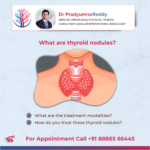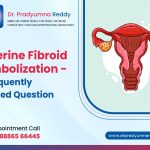The uterus is one of the most important reproductive organs in women which is located in the pelvis. There are two ovaries to produce eggs during the menstrual cycle and these eggs travel through the fallopian tubes.
The eggs are fertilized and implanted to the lining of the uterus. However, the uterus is prone to some medical conditions, and uterine fibroids are one of the debilitating conditions.
Fibroids are the unusual growth of tumours(fibrous tissues) on the walls of a woman’s uterus (womb). Usually, it is seen in nulliparous women. Most of the fibroid tumours are non-cancerous. They might turn into cancerous tumours in rare conditions, i.e. less than 0.1%.
Nearly 70 – 80% of women are prone to develop uterine fibroids by the age of 50, but not every woman develops signs & symptoms nor requires treatment. They don’t cause any discomfort in most of the cases.
Fibroids don’t appear the same in every woman; they vary in size, shape, and location. Fibroids may develop in multiple places in the uterus in the same women. The size of a fibroid ranges from a bean seed to a watermelon.
Let’s Know Some Facts About Uterine Fibroids
- Fibroids are medically termed as leiomyomas, myomas or fibromas.
Usually, Fibroids start to grow at the time of reproductive years, i.e., 16 to 50 years. During this time, the levels of estrogen hormones will be higher. - Fibroids are mostly non-cancerous and grow slowly.
- Around 30% of women may experience this condition by the age of 35yr and nearly 20 to 80% of women by the age of 50yr.
- Most fibroids don’t cause any complications, except in a few cases, they might grow severe.
- Experts perform extensive research to find the root cause and to provide effective treatment for fibroids.
Different Types Of Fibroids
In general, fibroids are categorized into different types considering the factors like their location they affect, i.e., on or within the uterus.
Intramural Fibroids: These are the common fibroid types diagnosed in 75% of women with this condition. They are mostly benign tumours and grow within the muscular uterus walls. They can become larger and increase your womb size.
Subserosal Fibroids: This type is diagnosed in 15% of women with fibroids. They grow under the membrane lining the outside uterus called serosa. They can grow giantly, making your womb look bigger on one side.
Submucosal Fibroids: This type of fibroids is diagnosed in 5% women. They are mostly grown under the membrane lining inside the uterine cavity.
Cervical Fibroids: This type of fibroids are diagnosed in 2.5% of women suffering fibroids. They mostly grow in your cervical area, i.e., the lower part of the uterus.
Pedunculated Fibroids: This type of fibroids are also diagnosed in 2.5% of women having fibroids. They can grow either inside or outside of your uterus. The stalk of tissues grows like a pedicle that looks like a mushroom.
What Are The Causes Of Uterine Fibroids?
The exact reason that causes uterine fibroids is not known. Usually, they are diagnosed during the reproductive years of a woman where the hormones, estrogen and progesterone production is higher.
Hormones: The ovaries produce the hormones estrogen and progesterone; they help to regenerate the uterus lining through every menstrual cycle; this may initiate the development of fibroids.
Genetics: Genetical changes might also result in fibroids. This is because some studies revealed that different genes are found in fibroids other than the regular genes of uterine muscle cells.
Hereditary: If your family members have fibroids, then you are likely to have this condition.
Risk Factors Of Uterine Fibroids
Below are some of the risk factors that can increase your chance of affecting from fibroids:
- Age is one of the factors that increase the risk of fibroids. Especially women in their 30s and 40s are more prone to this condition.
- Obese and overweight
- Some women may experience this during pregnancy months because of increased estrogen levels.
- Women who are taking birth control pills are also at risk of growing fibroids.
- Women who eat more red meat, the habit of drinking alcohol and caffeine intake also increases the risk of fibroids.
- African-American race women are also more likely to develop uterine fibroids compared to white women.
However, adding more fruits and vegetables to your regular diet might decrease the risk of fibroids. Childbearing, i.e. giving birth also decreases the risk of fibroids development in many women.
Symptoms Of Uterine Fibroids
In most cases, fibroids may not show any symptoms and don’t create any problems. Sometimes, you may not know that you are having fibroids unless a doctor diagnoses it at the time of regular check-ups.
However, some women experience the following symptoms if they have fibroids:
- Abnormal uterus bleeding
- Painful and irregular periods, sometimes associated with blood clots
- Pain in the pelvic area
- Painful sexual intercourse
- Swollen abdomen or uterus
- Anaemia
- Heavy menstrual cramps
- Longer periods
- Feeling pressure or fullness in your lower abdomen
- Urinating Frequently
- Constipation
- Pain in lower back and legs
- Complicated pregnancy, infertility, miscarriages, etc., are some other symptoms of uterine fibroids.
If the fibroids are very small or at the time of menopause, you may observe symptoms because of the production of hormones which stimulate the fibroid growth decrease and tend to shrink.
Treatment For Fibroids
A lot of treatment choices are available for treating fibroids of any size, which include medication, surgical and non-surgical treatment.
Medications
- Gonadotropin-releasing hormone (GnRH) can block hormone production and helps to treat fibroids.
- Tranexamic acid medicines can help to reduce heavy menstrual periods.
Menstrual bleeding can be controlled by oral contraceptives pills - NSAIDs can relieve pain caused by fibroids
- Vitamins and iron supplements can be used for menstrual bleeding and anaemia
Uterine Fibroid Embolization: In this procedure an interventional radiologist uses fluoroscopy to see inside the uterus and blood vessels. Then through a catheter inserted through your femoral artery in the groin embolic agents are delivered.
Embolic agents are administered into your fibroids to block the blood supplying arteries to the fibroids and eventually make them shrink. Studies say that about 95% of women undergoing Uterine Fibroid Embolization experience complete resolution from fibroid-related symptoms.
If fibroids are causing infertility or interfering in pregnancy, they should be treated as soon as possible. To know more information about treatment, contact Dr Pradyumna Reddy, the best interventional radiologist in Hyderabad. He has more than five years of experience in treating uterine fibroids.





